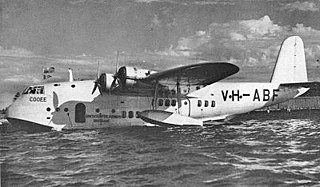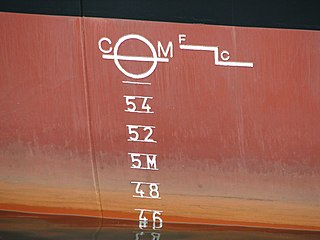
A hull is the watertight body of a ship, boat, submarine, or flying boat. The hull may open at the top, or it may be fully or partially covered with a deck. Atop the deck may be a deckhouse and other superstructures, such as a funnel, derrick, or mast. The line where the hull meets the water surface is called the waterline.

A ship is a large vessel that travels the world's oceans and other navigable waterways, carrying cargo or passengers, or in support of specialized missions, such as defense, research and fishing. Ships are generally distinguished from boats, based on size, shape, load capacity and purpose. Ships have supported exploration, trade, warfare, migration, colonization, and science. Ship transport is responsible for the largest portion of world commerce.

A flying boat is a type of fixed-winged seaplane with a hull, allowing it to land on water. It differs from a floatplane in having a fuselage that is purpose-designed for flotation, while floatplanes rely on fuselage-mounted floats for buoyancy.

A seaplane is a powered fixed-wing aircraft capable of taking off and landing (alighting) on water. Seaplanes are usually divided into two categories based on their technological characteristics: floatplanes and flying boats; the latter are generally far larger and can carry far more. Seaplanes that can also take off and land on airfields are in a subclass called amphibious aircraft, or amphibians. Seaplanes were sometimes called hydroplanes, but currently this term applies instead to motor-powered watercraft that use the technique of hydrodynamic lift to skim the surface of water when running at speed.

The Short S.25 Sunderland is a British flying boat patrol bomber, developed and constructed by Short Brothers for the Royal Air Force (RAF). The aircraft took its service name from the town and port of Sunderland in North East England.
This glossary of nautical terms is an alphabetical listing of terms and expressions connected with ships, shipping, seamanship and navigation on water. Some remain current, while many date from the 17th to 19th centuries. The word nautical derives from the Latin nauticus, from Greek nautikos, from nautēs: "sailor", from naus: "ship".
Hull speed or displacement speed is the speed at which the wavelength of a vessel's bow wave is equal to the waterline length of the vessel. As boat speed increases from rest, the wavelength of the bow wave increases, and usually its crest-to-trough dimension (height) increases as well. When hull speed is exceeded, a vessel in displacement mode will appear to be climbing up the back of its bow wave.

The Bogue class were a class of 45 escort carriers built in the United States for service with the US Navy and the Royal Navy, through the Lend-Lease program, during World War II. Following the war, ten Bogue-class ships were kept in service by the US Navy and were reclassified for helicopter and aircraft transport operations.

The Beriev Be-12 Chayka is a Soviet turboprop-powered amphibious aircraft designed in the 1950s for anti-submarine and maritime patrol duties.

Rowing is the act of propelling a human-powered watercraft using the sweeping motions of oars to displace water and generate reactional propulsion. Rowing is functionally similar to paddling, but rowing requires oars to be mechanically attached to the boat, and the rower drives the oar like a lever, exerting force in the same direction as the boat's travel; while paddles are completely hand-held and have no attachment to the boat, and are driven like a cantilever, exerting force opposite to the intended direction of the boat.

A bulbous bow is a streamlined flaring or protruding bulb at the bow of a ship just below the waterline. The flare or bulb modifies the way the water flows around the hull, reducing drag and thus increasing speed, range, fuel efficiency, and stability. Large ships with bulbous bows generally have twelve to fifteen percent better fuel efficiency than similar vessels without them. A bulbous bow also increases the buoyancy of the forward part and hence reduces the pitching of the ship to a small degree.

De Grasse was an anti-aircraft cruiser of the French Navy. She was the first French vessel named in honour of François Joseph Paul, Marquis de Grasse Tilly, Comte de Grasse. From 1965 to 1971, she was involved in the nuclear test campaigns in the Pacific.

A vessel's length at the waterline is the length of a ship or boat at the level where it sits in the water. The LWL will be shorter than the length of the boat overall as most boats have bows and stern protrusions that make the LOA greater than the LWL. As a ship becomes more loaded, it will sit lower in the water and its ambient waterline length may change; but the registered L.W.L is measured from a default load condition.

Length overall is the maximum length of a vessel's hull measured parallel to the waterline. This length is important while docking the ship. It is the most commonly used way of expressing the size of a ship, and is also used for calculating the cost of a marina berth.

The Sverdlov-class cruisers, Soviet designation Project 68bis, were the last conventional gun cruisers built for the Soviet Navy. They were built in the 1950s and were based on Soviet, German, and Italian designs and concepts developed before the Second World War. They were modified to improve their sea capabilities, allowing them to operate at high speeds in the rough waters of the North Atlantic. The design carried an extensive suite of modern radar equipment and anti-aircraft artillery. The Soviets originally planned to build 40 ships in the class, to be supported by the Stalingrad-class battlecruisers and various aircraft carriers.

The draft or draught of a ship is a determined depth of the vessel below the waterline, measured vertically to its hull's lowest—its propellers, or keel, or other reference point. Draft varies according to the loaded condition of the ship. A deeper draft means the ship will have greater vertical depth below the waterline. Draft is used in under keel clearance calculations, where the draft is calculated with the available depth of water to ensure the ship can navigate safely, without grounding. Navigators can determine their draught by calculation or by visual observation.

The load line, also known as Plimsoll line, indicates the legal limit to which a ship may be loaded for specific water types and temperatures in order to safely maintain buoyancy, particularly with regard to the hazard of waves that may arise. The load line is a waterline that corresponds to the maximum draft of the ship, thus yet another name, load waterline. Varying water temperatures will affect a ship's draft, because warm water is less dense than cold water, providing less buoyancy. In the same way, fresh water is less dense than salinated or seawater with a similar lessening effect upon buoyancy. The rules for international load lines are defined by the International Convention on Load Lines from 1966. For inland water transport regional, national or local rules apply.
The waterline is where the hull of a ship meets the surface of the water. The load waterline is a special marking indicating the legal load limit of a ship, and, in naval architectural plans, it is any line drawn to delineate hull shape that is in a plane parallel to the surface of the water.

The Lioré et Olivier LeO H-23 was a French military flying boat, primarily intended for coastal reconnaissance, though able to carry a small bomb load. Only one was built.

Lofting coordinates are used for aircraft body measurements. The system derives from the one that was used in the shipbuilding lofting process, with longitudinal axis labeled as "stations", transverse axis as "buttocks lines", and vertical axis as "waterlines" (WL). The lofting coordinate frame is similar, but not the same as aircraft principal axes used to describe the aircraft flight. For the US-manufactured aircraft the ticks on the axes are labeled in inches,.
















